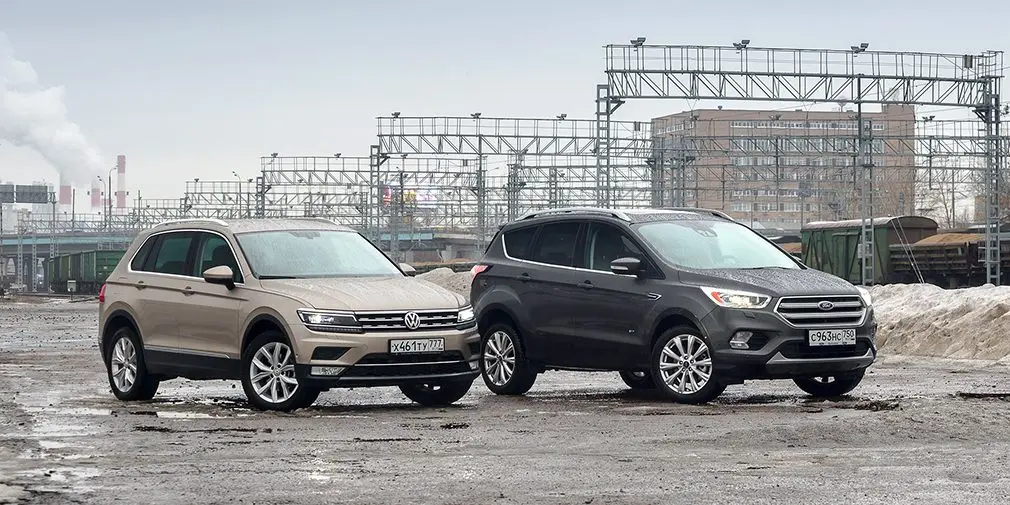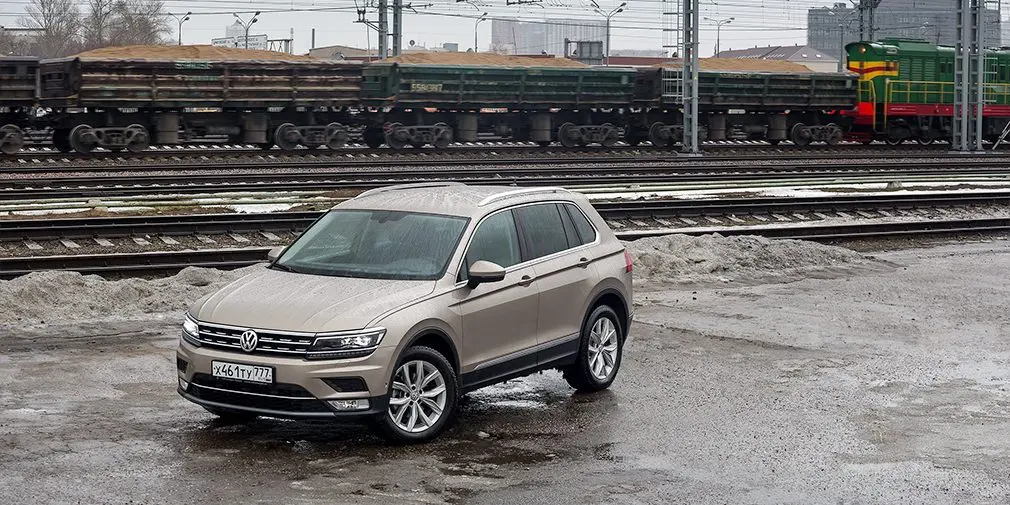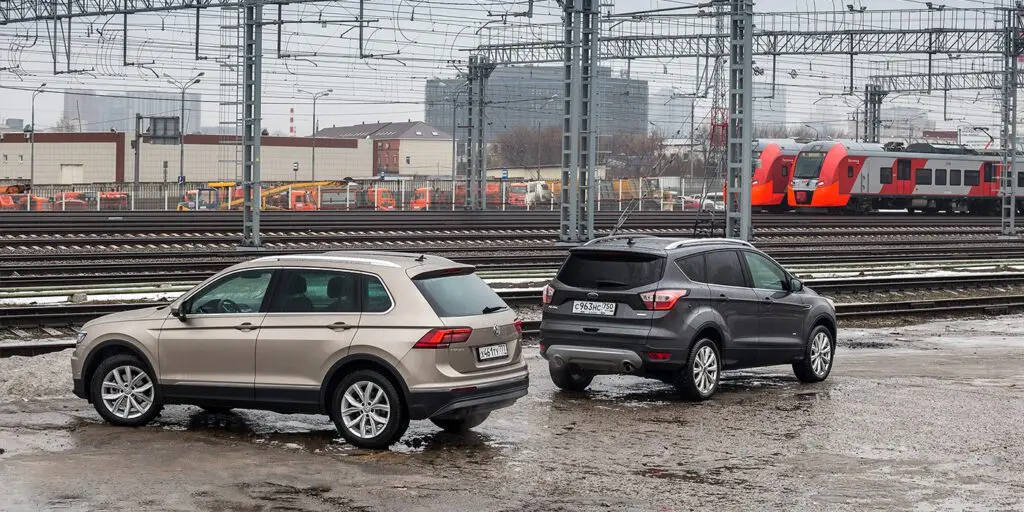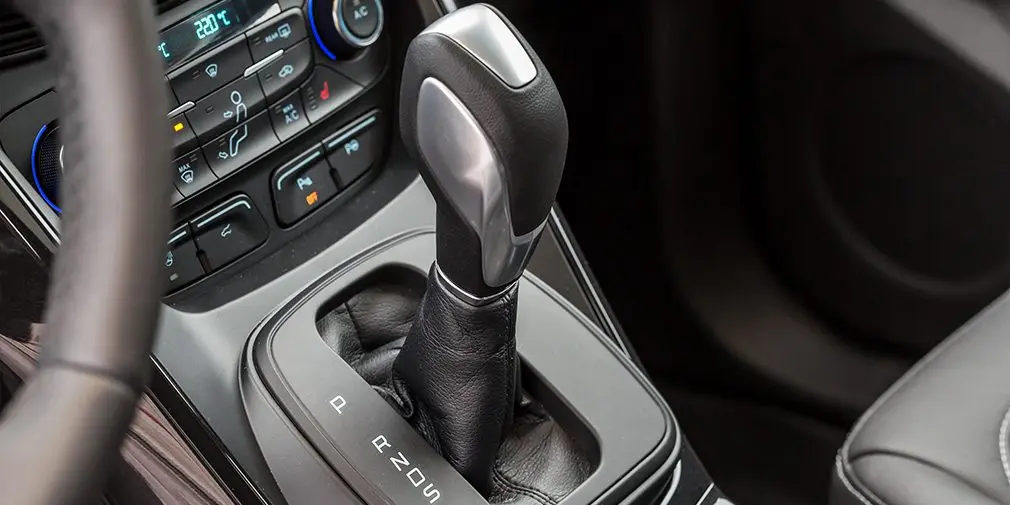
Test drive Ford Kuga and Volkswagen Tiguan
B-class hatchbacks are raised above the ground. The mastodons of the real off-road segment are losing their hardcore off-road arsenal - all for the sake of the growing popularity of crossovers
They love crossovers in Russia. This is not a secret to anyone, and these are not just words! Last year, the share of cars in this class exceeded 40% - almost half of the market. And the traditionally abused Russian roads have nothing to do with it - this is the global trend. All over the planet, the popularity of cross-country vehicles is only increasing, and now everyone has rushed into this segment. B-class hatchbacks are raised above the ground. The mastodons of the real off-road segment are losing their hardcore off-road arsenal. Luxury brands, which previously produced entirely sedans, and coupes with convertibles, and they are racing to roll out their new items with all-wheel drive and clearance of 180 millimeters onto the stage of the motor show. However, there are those who have long chosen this niche. Two of these old-timers have recently undergone important changes: the Ford Kuga crossover has been updated, a new generation of Volkswagen Tiguan has been released. It is these cars that look like the main contenders for the buyer in the popular segment.
First impressions are often deceiving. So in our case, it is easier to mistake the Kuga for the new generation car than the Tiguan. "Blue ovals" thoroughly conjured over the exterior of the crossover, leaving the same platform. The Germans remained faithful to the strict design, although the "cart" here is completely new - the modular MQB. Ford Kuga has radically changed its "face" and "stern". There are new adaptive bi-xenon headlights, an Edge-styled grille and taillights reminiscent of the Explorer SUV, but not too far into the fenders. But in profile, the car is recognizable at a time - the silhouette and line of the windows are identical. At the Tiguan, the opposite is true: one hundred percent recognition of the generational change is possible only in profile, here the differences in forms become obvious. And on the front and back, they look more like cosmetic ones.
Inside, the situation is diametrically opposite. The interior of the new German crossover has literally nothing to do with the interior of its predecessor. Here is a completely different architecture, new digital instruments, a scattering of keys at the gear selector. Single horizontal rectangular air ducts replaced the vertical pairs of round ones from the previous car. Even the armrests on the doors and power window units have changed dramatically. The only thing that remained the same was the volume control of the audio system, along with which, as usual, the power-on icon rotated absurdly. But this is the traditional "feature" of Volkswagen cars, which seems to be with us forever.

From Kuga such radical changes should not be expected. The air ducts are the same, and the steering wheel is new, with three spokes and more ergonomic control keys for everything and everyone. The devices are identical to the old ones, only the graphics of the screen have changed, but the multimedia system has been completely updated. The display moved lower and became larger, and the control keys now do not occupy the lion's share of the center console, but are compactly located on the "window sill" in front of the display. The gear lever remained the same, only it lost the swinging button for switching the steps, instead of which there are now normal paddle shifters, but the climate control unit is completely new.
In terms of ergonomics, both machines balance at roughly the same level. Each has its own advantages, but they are immediately balanced out by the disadvantages. The Tiguan multimedia system supports multitouch technology and works with mobile devices using Apple CarPlay and Android Auto protocols, it learns about the approach of a hand according to the indications of infrared sensors and displays the relevant buttons on the screen. The digital instrument cluster in the crossover is the same as in its relatives - Audi cars - it shows excellent graphics and convenience, worthy of the 21st century.

But try turning on the heated steering wheel on a German SUV! To do this, you must first press the physical button for heating the seats, then press the steering wheel icon again, but on the screen. Shutdown occurs in the same sequence. It seems that everything is not difficult, but if we assume that you want to warm up only the steering wheel, or leave the steering wheel heating working longer than the heated seats ... Turned the seats to the maximum, turned on the steering wheel, turned off the seats. Or - turned on the chairs, turned on the steering wheel, turned off the chairs, was going to turn off the steering wheel, the chairs themselves turned on to the maximum, turned off the steering wheel, turned off the chairs. This is annoying.
With Kuga, the opposite is true again. Each action has its own physical key. It is more convenient and logical, but the screen of the multimedia system is located in a niche, the walls of which partially obscure the view. In addition, you have to reach for the on-screen buttons. There is also support for "multi-finger" gestures and protocols Apple CarPlay and Android Auto.

Both cars allow you to configure several driver profiles, each with its own set of radio stations and modes of operation of auxiliary systems. By the way, they also differ noticeably. Adaptive cruise control is only available in Volkswagen, and it works great - both in traffic jams and in fast traffic. Kuga, instead, knows how to keep within the lane. Crossovers can park on their own, but the Tiguan is only parallel, and the Ford is also perpendicular. Plus, he can steer himself from a parallel parking lot.
The Kuga also wins in terms of spaciousness in the cabin: the car itself is longer than the Volkswagen, and its wheelbase is larger, so there is really a lot of space for both front and rear passengers. But in terms of trunk volume, the Tiguan is in the lead. Moreover, in the standard position of the seats, the difference is small - 470 liters versus 456 liters, that is, if its sliding rear sofa is moved all the way forward (Kuga is not available), then it grows to 615 liters and the difference becomes huge. Both cars have an electric boot lid and Hands-free kick opening under the rear bumper.
Under the hoods of the test crossovers, supercharged gasoline engines. However, the Volkswagen Tiguan has a two-liter engine, while the Ford Kuga has a 1,5-liter engine. The latter, for nothing that is less, slightly bypasses the German unit in terms of power - 182 hp. against 180 "horses" from the German crossover. However, the dynamics of the Kuga loses, and noticeably. If the Tiguan exchanges a “hundred” in 7,7 seconds, then Ford spends 10,1 seconds on it. In addition, the Kuga has a higher average fuel consumption: with the same passport consumption of 8 liters per 100 kilometers, in the real world Volkswagen "eats" a liter and a half less than Ford. The selected gearboxes are primarily to blame for this difference.
While Volkswagen stays true to the very fast but controversial DSG gearbox (on our car it is seven-speed), Ford, on the contrary, sacrifices speed in favor of a proven solution: the Kuga has a classic torque converter automatic 6F35. It is in its depths that the lion's share of the engine's efforts melts. This transmission is installed, in particular, on the Ford Explorer. And to be honest, it suits him better. Still, such a difference in dynamics with the main competitor is a minus.

However, the "Ford" solution has its advantages: the automatic transmission works much smoother and more intelligent than the "robot". DSG still periodically sins with pokes when switching. Kuga in this pair generally votes for comfort. Its suspension is noticeably better at handling large irregularities and the point is not that it is perfectly tuned. The problem is the Tiguan. Each speed bump on it is a tangible and unpleasant blow, and not a squeeze, but a rebound! Periodically, this is accompanied by the operation of the traction control system, which, under the cheerful flashing of the lights, momentarily cuts off the fuel supply to the engine. It's not fun at all - you get scared out of habit.
On smaller bumps, the difference is not so noticeable - the Kuga is slightly softer, the Tiguan is noticeably quieter. In general, it is so well soundproofed that even your own horn sounds as if you are sleeping in a bed, covering your head with a blanket, and honking on the street, behind a good double-glazed window. Surreal feeling. So the irregularities pass the same way - the car vibrates, and there is practically no sound from the tires. In Volkswagen, you can sleep well, parked next to a busy intersection - this is not a figure of speech, I checked.

Curiously, the difference in suspension feel has little to no effect on handling. Of course, you can't argue against physics, and a slightly stiffer and squat Tiguan is more stable in corners and demonstrates less roll, but how important this quality is for a crossover is up to everyone to decide for himself. The Kuga is more prone to roll and wobble, which is again quite natural, but in the accuracy of the steering response and the transparency of the feedback, the differences between the cars are insignificant.
The difference between crossovers is more noticeable in their off-road potential. Both manufacturers claim a ground clearance of 200 mm, however, due to the lack of a measurement standard, the actual figures for the minimum ground clearance are different. The bottom point of the Tiguan is 183mm above the ground, while the Kuga's is 198mm. Moreover, in terms of geometric cross-country ability, Ford is also in the lead. And if the exit angle for Volkswagen is almost a degree greater (25 ° versus 24,1 °), then the approach angle is greater for the Kuga, and already by 10,1 ° (28,1 ° versus 18 °).

Where Ford wins accurately and unconditionally is the price: in the minimum configuration it will cost the buyer $ 18, while the similar Tiguan costs $ 187. Yes, Volkswagen has simpler and more affordable versions, but even a 22-horsepower front-wheel drive car will cost $ 012 with an engine weaker than 125 hp. not offered at all. Cars with such units as we have on the test cost at least $ 19 and $ 242. respectively, and $ 150 difference - the advantage is more than noticeable.
Who is better? I have no definite answer to this question. Each of the cars has not only its own obvious advantages, but also no less obvious disadvantages. So in each specific case the answer will be different - it all depends on which "chips" are more important to the buyer, and what shortcomings he is ready to turn a blind eye to. Thinking about the conclusion, for some reason I remembered about architecture: Ford Kuga is Art Deco, Volkswagen Tiguan is Bauhaus. Like modern crossovers, these styles were international, but the former was more popular with the Americans and the latter with the Germans. The first focused on the charm of complex shapes, the second on the beauty of simple lines. However, both approaches are beautiful in their own way and the question "which is better?" in fact, it is inappropriate to ask "what do you like best?"
| Body type | Crossover | Crossover |
| Dimensions (length / width / height), mm | 4524/1838/1703 | 4486/2099/1673 |
| Wheelbase, mm | 2690 | 2604 |
| Curb weight, kg | 1682 | 1646 |
| engine's type | Petrol, 4-cylinder, turbocharged | Petrol, 4-cylinder, turbocharged |
| Working volume, cubic meters cm | 1498 | 1984 |
| Max. power, l. from. at rpm | 182/6000 | 180 / 4500-6200 |
| Max. cool. moment, Nm | 240/1600-5000 | 320/1700-4500 |
| Drive type, transmission | Full, 6-speed automatic transmission | Full, 7-speed robotic |
| Max. speed km / h | 212 | 208 |
| Acceleration from 0 to 100 km / h, s | 10,1 | 7,7 |
| Fuel consumption (mixed cycle), l / 100 km | 8,0 | 8,0 |
| Price from, $. | 18 187 | 19 242 |